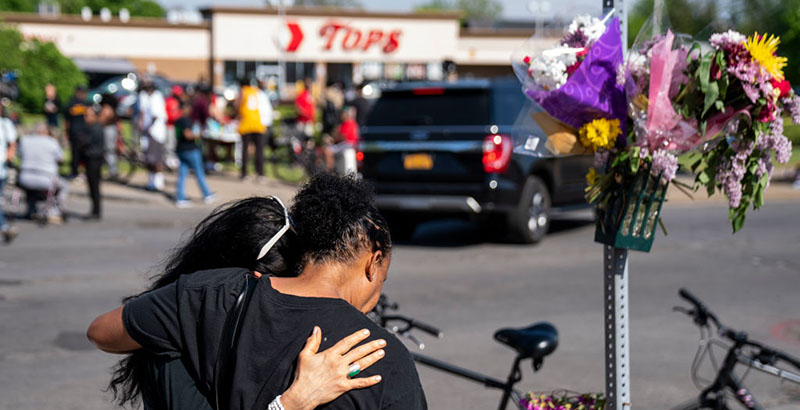Buffalo Shooting Suspect Made Threat at School But Wasn’t on NY ‘Red Flag’ List
A teacher told state police about suspect's post-graduation plans involving ‘murder and suicide.’ He was still allowed to buy an assault rifle

Get stories like this delivered straight to your inbox. Sign up for The 74 Newsletter
The suspect accused of killing 10 people and wounding three others at a supermarket shooting in Buffalo, New York, on Saturday made statements last year that alarmed a teacher at his high school enough to call law enforcement.
According to New York Gov. Kathy Hochul, speaking Monday morning on a Buffalo radio station, a teacher asked Payton Gendron what his plans were for after his upcoming graduation last year from Susquehanna Valley High School, located near Binghamton.
“He said, ‘I want to murder and commit suicide,’” Hochul said. “So they immediately took action.”
On June 8, 2021, state police took Gendron to a hospital, where he underwent a psychiatric evaluation but was released — possibly because he had not made a specific threat against any individual.
“The state police responded,” National Public Radio quoted Buffalo Police Commissioner Joseph Gramaglia as saying. “They investigated. They interviewed the subject. And they felt at the time it was appropriate to have that individual brought in for a mental health evaluation.”
After he graduated two weeks later, the New York Times reported, Gendron “fell off investigators’ radar.” It’s not clear why he was not on a so-called red flag list of people whose threats of violence bar them from owning or purchasing weapons when he recently bought a Bushmaster semiautomatic from a dealer in Endicott, New York.
Hochul said she had ordered an investigation into how the 18-year-old was able to purchase an assault rifle despite the interaction with state police. In 2019, New York state enacted a law that allows a judge to issue an “extreme risk protection order” preventing a person suspected of being a threat to themselves or others from buying a gun.
The District of Columbia and 19 states have red-flag laws, 14 of them enacted in the wake of the school shooting in Parkland, Florida. The laws enable courts to intervene, typically when relatives or law enforcement present evidence a person has exhibited warning signs of possible future violence.
According to a 2020 examination of the new laws by The 74, New York’s law goes a step further than most, allowing educators to petition a judge directly, rather than attempt to get a parent or law enforcement agency to do so. Hawaii and California have since adopted similar provisions. Research into the laws’ effectiveness at preventing mass shootings is mixed.
Last fall, The Pew Charitable Trusts examined the laws’ implementation and found a lack of public education about them, including among the agencies that are most likely to receive reports about troublesome behavior.
“You pass the law and then nothing happens,” Jeffrey Swanson, a professor of psychiatry and behavioral sciences at Duke University School of Medicine and a leading researcher on red flag laws, told Pew. “There’s no real systematic efforts to invest in letting people know about it, educating the stakeholder groups who need to know about it, setting up the infrastructure and protocol to do it.”
According to former classmates interviewed by the Times, the remarks that alarmed Gendron’s teacher followed a pattern of odd behavior that included showing up at school in hazmat gear after COVID restrictions ended. “He wore the entire suit, boots, gloves, everything,” Nathan Twitchell, 19, told the newspaper. “Everyone was just staring at him.”
Former classmates said they knew that Gendron was interested in guns but didn’t find that unusual in their rural community. In a 180-page online “manifesto” filled with racist, anti-Semitic and anti-immigrant theories, the suspect wrote at length about different kinds of firearms as well as his admiration for past mass murderers.
Gendron said he was “radicalized” online as a white supremacist while “bored” during the pandemic, a phenomenon experts on extremism say is increasingly common. “A lot of it is happening in plain sight,” Jinnie Spiegler, director of curriculum and training at the Anti-Defamation League, told The 74. “There’s the concern on a personal level that young people are getting sucked into it, frankly,” she said, adding that a growing proliferation of hate speech online “sets the stage for that next level of literal white supremacist ideology.”
Get stories like these delivered straight to your inbox. Sign up for The 74 Newsletter

;)
